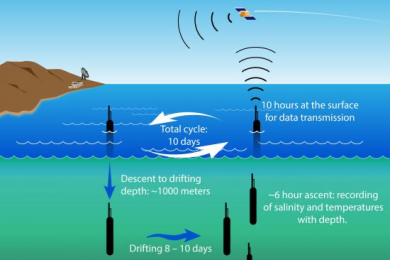The Array for Real-time Geostrophic Oceanography (ARGO) is an international collaboration effort that has been established to collect temperature and salinity profiles data from the upper ocean to intermediate depths. The ocean data is collected using specially-built autonomous devices, drifting at sea. Since the year 2000, around 800 of these devices are installed each year.
While various models of these devices are in operation currently, the data collection proceeds in a similar fashion. After ten days of drifting at various depths, the devices pump fluid into an external bladder as a way to rise to surface. Within the 6 hours of ascent the devices record information on sea salinity and temperature. At the surface, the position of the devices is detected via satellites or GPS and the collected data is transmitted using satellite telecommunications. After the transmission of data the bladder deflates and the float sinks again and begins a new 10-day ocean observation cycle.
Currently, Argo floats are providing in the order of 100,000 temperature and salinity profiles as well as velocity measurements every year, targeting global ocean observation information at average 3-degree spacing. All data collected are publically available in near real-time through the Global Data Assembly Centers (GDACs) in Brest, France and in Monterey, California. Before the release, data is checked using an automated quality control procedure; and additional scientific quality control is carried out by GDACs within one year of the collection.
The objectives of Argo include the provision of a quantitative description of the changing state of the upper ocean and the patterns of ocean climate variability over years, the enhancement of the value of the Jason altimeter through the measurement of subsurface temperature, salinity, and velocity. Data gathered with these ARGO devices are contributing to the development of ocean and coupled ocean-atmosphere forecast models and as a primary priority for the documentation of seasonal to decadal climate variability which is needed to understand and predict climate patterns worldwide.

